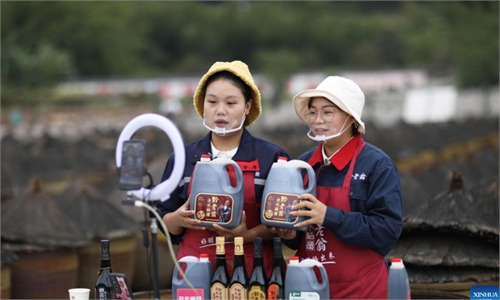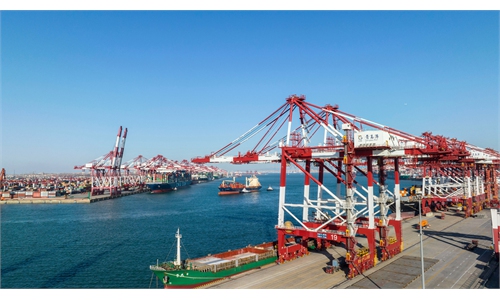From stable CPI to rosy local GDP targets, more signs show China’s fast economic rebound

Tourists go shopping and enjoy the festive atmosphere on Yandaixie Street at Houhai, a scenic spot in Beijing on January 12, 2023. Photo: VCG
All told, the world's second-largest economy is on track to become one of the fastest growing major economies in 2023, as many advanced economies are set to face serious slowdown and the global economy is "perilously close" to recession, according to various reports and economists, pointing to China's better-than-expected recovery from recent COVID-19 outbreaks.
Still, China's economy will face grim challenges and risks that the global economy as a whole will face, including elevated inflation and higher interest rates in some major economies like the US and rising economic and geopolitical tensions, which requires more effective measures to ensure stable economic operations, analysts noted.
Uplifting signs
Despite both internal and external pressure on prices, China's consumer price index (CPI), a main gauge of inflation, rose 2 percent year-on-year in 2022, according to data from the National Bureau of Statistics (NBS) on Thursday. While the consumer inflation rate accelerated in December to 1.8 percent from 1.6 percent in the previous month, the full-year CPI is well below China's target of around 3 percent set at the beginning of 2022.
Thanks to China's efforts to better coordinate epidemic response and economic and social development and the country's adoption of measures to ensure market supply and stabilize prices, prices remained generally stable, said Dong Lijuan, chief statistician with the NBS.
China's overall stable prices, in stark contrast to serious inflationary risks in the US and the euro zone, mean that "the country's monetary policy still has room to remain loose," Tian Yun, a Beijing-based economist, told the Global Times on Thursday.
China's sufficient room for monetary and fiscal policy to boost economic growth is also what's driving improvement in the country's economic outlook. China's central bank vowed earlier this month to use varied monetary policy tools to maintain reasonably ample liquidity in 2023, while aiming to ramp up financial support for domestic consumption to accelerate economic growth.
Also on Thursday, Shu Jueting, a spokesperson for the Ministry of Commerce (MOFCOM), said that China's total import and export exceeded the $5 trillion and the $6 trillion marks in a row and the scale is expected to reach a new high in 2022. "China's foreign trade has withstood the test of major risks, showing strong resilience and vitality," Shu said, while noting the turmoil in the global economic and trade environment.
China's foreign trade still faces growing downward pressure with weakening external demand and falling orders, but judging from a group of trade firms tracked by the MOFCOM, due to a series of measures to boost trade, some positive signals have emerged and the situation of receiving orders in major exporting provinces has improved, Shu said.
He Weiwen, a senior fellow at the Center for China and Globalization, said various external risks, including US' crackdown measures against China, have led to a clear decline in China's exports, adding the export situation may be even more serious this year.
"Under various challenges, the country needs to vigorously support small and medium-sized enterprises, stimulate consumption, solve employment issues, and need more practical policies to deal with uncertainties," He told the Global Times on Thursday.
In fact, domestic consumption is what Chinese policymakers count on for boosting overall economic growth, with the Central Economic Work Conference at the end of 2022, which mapped policy priorities for 2023, stressed an emphasis on boosting domestic consumption. And given China's better-than-expected recovery from the epidemic, many are also expecting a faster consumption recovery.

Shougang Park in Beijing held a New Year countdown event on December 31, 2022, with a light show and some artistic performances. Ten minutes before the arrival of 2023, a screen began to light up the celebration picture of "Happy New Year" and the crowd started counting down to welcome the New Year. Photo: Li Hao/GT
Beyond expectationsTian said that many places across the country have returned to pre-pandemic normalcy in areas such as car and foot traffic and tourism. "In fact, as I have said it before, this is actually beyond expectations," he said.
Likely boosted by such a fast recovery, many Chinese local economic powerhouses have set high GDP growth targets for 2023. As of Thursday, many local governments, including that of Shanghai, East China's Fujian and Jiangxi, have released their 2023 GDP growth targets, with all setting a GDP growth rate of 5.5 percent or above, Xinhua reported on Thursday.
While these targets come after a low base in 2022, they are still reflective of the growing expectation and confidence in a faster GDP growth rate in 2023, given the size of these local economies, analysts said. That also mirrors China's overall economic outlook this year, in that the Chinese economy will see a faster rate this year due to both a low base last year as well as its recovery pace, they noted.
While some foreign financial institutions have remained rather cautious and even pessimistic about China's prospect, their forecasts for China's GDP growth in 2023 are also much better than that of other major economies.
In its latest Global Economic Prospects report released on Tuesday, the World Bank forecast that China's economy will grow at 4.3 percent in 2023, 0.9 percentage point below its previous forecast six months ago. However, the downgrade of China's growth rate is much smaller compared to a 1.3-percentage-point cut to the forecast for global growth and a 1.9-percentage-point cut for the US.
Chinese economists said that the World Bank and other foreign institutions make their predictions based on the new epidemic situation that started in November. However, the pace of China's recovery from the epidemic in terms of economic activities has exceeded expectations.
The World Bank's downgrading of China's GDP growth is based on the spread of the Omicron variant in China in the last quarter of 2022; however, given the recovery pace, China's economy could reach a growth rate of 5.5 percent in 2023, if there were no "extreme factors" like worsened epidemic situation and escalation of the Russia-Ukraine conflict, Cao Heping, an economist at Peking University, told the Global Times on Thursday.






